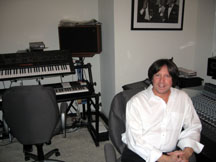
•home
RORY KAPLAN
Rory Kaplan hit the road at age 17 as a guitarist and keyboard player, later adding arranger, composer and musical director to his resume. Along the way, he developed his synthesizer playing and programming skills touring with the likes of Chick Corea, Herbie Hancock, the Crusaders, Randy Crawford, Jeff Beck, Stanley Clarke, Stevie Wonder, Christopher Cross, the Jacksons, Michael Jackson and Donny Osmond.
Rory picked up engineering and mixing techniques sitting alongside Al Schmitt, Elliot Scheiner, Chuck Ainlay and Dave Tickle as he played a major role in producing and evangelizing 5.1 material for DTS, as well as producing and/or performing in the studio with artists such Edgar Winter, Yes, Belinda Carlisle, Joe Cocker, Natalie Cole and many others.
An early technology adopter who was one of the first to acquire a Minimoog and work with the Fairlight CMI system, Kaplan later weathered the transition from real to virtual keyboards, although his first PC-based audio systems were less than reliable. That is, until he was introduced to PC AudioLabs. With Intel multi-core chips now available, Kaplan reports that he has been getting back into studio technology big time with a new PC AudioLabs system.
“I just got the quad core and I’m just rebuilding my entire studio around it,” he reveals. “I decided if I’m going to run quad core then I really need a real room, so I went and got the SSL AWS900+ board and interface.”
Support from PC AudioLabs was impressive, he comments. “Basically, they get it done. If my stuff needed to be updated or anything needed doing it was done within the next few days--and it’s not like I’m the only client in town.”
According to Kaplan, firing up the new Intel-based PC was a revelation. “I just figured out last week that I’m not limited anymore. Years ago it was a real big deal to have a lot of plug-ins on a file; you would get to so many in a 32-bit system and it would just crash. I have a couple of Universal Audio cards as well as plug-ins from the system. I just loaded a whole bunch of stuff--I had every compressor, every plug-in and every EQ on all 48 channels at 24/96. I could get as many tracks as I wanted; I just had to stem them down to 48 to monitor. It kinda blew my mind!”
As an experiment, he says, he up-sampled a project from 48kHz to 96kHz to see how it rendered. “I used to wait minutes and minutes for that to happen.” But now, he says, “I looked down to turn off a piece of gear and looked up and it was done.”The shorter computation time helps maintain the creative process, he believes. “I really hate sitting there while files render. You’re sitting there in creative mode and nothing’s happening because you’ve got to wait for calculations.“
He continues, “Between the PC AudioLabs machines, quad core Intel chips and the software that is available now, it just makes life much easier and productive. You get a PC from PC AudioLabs and you just go. I’m writing music now; I’m not computing, I’m not rendering, I’m just being creative. They make such a great product that it becomes transparent, and it’s absolutely designed for music applications. Between the new SSL board and working with the PC AudioLabs computer--all my stereo stuff is at 96kHz & 192kHz and my surround is at 96kHz--I’m actually able to be productive instead of waiting for things to work.”
Kaplan continues, “The other fun thing I enjoy about PC AudioLabs and Intel with the quad core, even the dual core, is that on the old systems you’d watch the performance meter showing processing power, and as soon as you got about six or seven plug-ins the thing was choking at 75 or 80 percent. As soon as you got another five or six compressors on there, you saw the light come on with the meter pegged and it would crash. On the dual core and the quad core PC AudioLabs Intel machine, I had all these plug-ins on there and it was at 10 or 15 percent. There’s some serious headroom there!"
The power of the Intel multi-core processors allows Kaplan to be fairly agnostic about the production software that he favors. “I’ve been using Nuendo since ’99. But I will say that SONAR 6 is the first software that is running at true 64-bit with all its plug-ins. They’ve really tapped into the multicore processors for speed.”Over the last eight or nine years, says Kaplan, the PC has become more stable and reliable and better supported by software developers, to such an extent that it has become accepted as an alternative to the more traditional Mac system in music production. “Half the engineers and producers I know are Apple-based because of Pro Tools and the other half are PC-based because they are running Nuendo or Cubase or SONAR or some other software. I think, for someone new coming into it, they need to do their research. You don’t want to be persuaded by what is popular, you want to do what’s best for your work. I never buy a piece of gear because it’s cool, I buy it because it’s functional.”
Photo File: Rory_Kaplan.JPG
Intel is a registered trademark of Intel Corporation or its subsidiaries in the United States and other countries.
* Other names and brands may be claimed as the property of others.
Contact:
Dan Snyder
PR Manager, Intel Corporation
daniel.s.snyder@intel.com
(408) 765-6398

